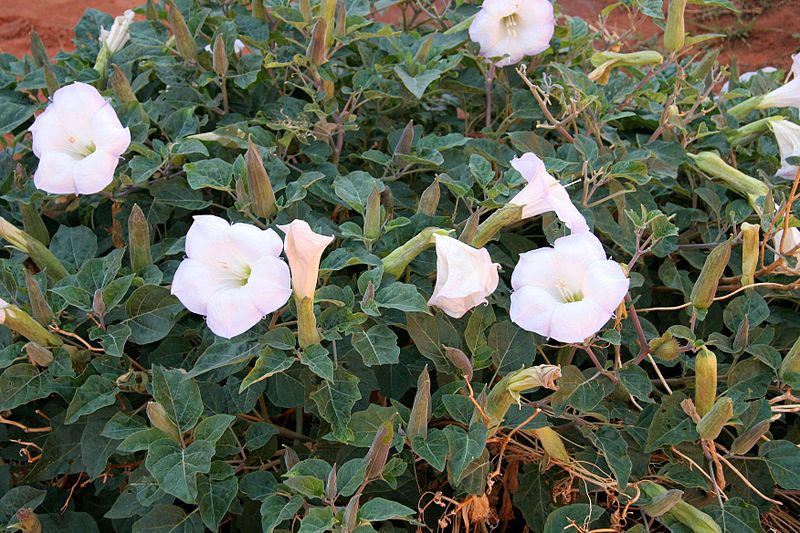Benutzer-Werkzeuge
Datura wrightii Regel - Solanaceae - sacred thorn-apple, sacred datura, Wrights Stechapfel, Kalifornischer Stechapfel
Perennial herb, 30-150cm tall, native to North America (Mexico and southern US); „The flowers are the most striking feature, being sweetly fragrant white trumpets up to 20 cm (8 inches) long, often tinted purple, especially at the margin. There are five narrow points spaced symmetrically around the rim… In the U.S. it is sometimes called „Western Jimson weed“ because of its resemblance to Datura stramonium. Anglophone settlers in California often called it „Indian whiskey“ because of its ritual intoxicating use by many tribes; the name „sacred datura“ has the same origin. “ http://en.wikipedia.org/wiki/Datura_wrightii
„Although the floral scent of D. wrightii comprises at least 60 compounds, only nine of those elicited robust neural responses. Behavioral experiments confirmed that these nine odorants mediate flower-foraging behaviors, but only as a mixture. Moreover, the mixture evoked equivalent foraging behaviors over a 1000-fold range in dilution, suggesting a singular percept across this concentration range. Furthermore, neural-ensemble recordings in the moth's antennal lobe revealed that reliable encoding of the floral mixture is organized through synchronized activity distributed across a population of glomerular coding units, and this timing mechanism may bind the features of a complex stimulus into a coherent odor percept… The D. wrightii flower produces a chemically diverse fragrant scent containing: monoterpenoids (MO) such as trans-β-ocimene and geraniol; aromatics (AR) like benzyl alcohol and benzaldehyde; sesquiterpenoids (SE) including E-caryophyllene and α-farnesene; aliphatics (AP) such as cis-3-hexen-1-ol and 2-hexanone… An analysis of population-level responses demonstrated strong ensemble selectivity for a group of nine odorants. To examine odorant-evoked responses between preparations (n = 16), we calculated the percentage of excited units (response index [RI] ≥ 2.0) in each ensemble for each odorant (Figure 1D). This analysis confirmed that many units were activated by one or more members of this same group of nine odorants: benzaldehyde (bea), benzyl alcohol (bol), linalool (lin), nerol (ner), β-myrcene (myr), methyl salicylate (mal), geraniol (ger), E-caryophyllene (car), and α-farnesene (far) (odorants 23–31, respectively). The remaining odorants evoked little or no activity in most units.“
[Riffell, J. A., Lei, H., Christensen, T. A., Hildebrand, J. G., Characterization and coding of behaviorally significant odor mixtures. Current Biology, Vol.19(4), 2009, 335-340] http://www.sciencedirect.com/science/article/pii/S0960982209006137

Datura wrightii Wikimedia Commons (copyright = public domain)
